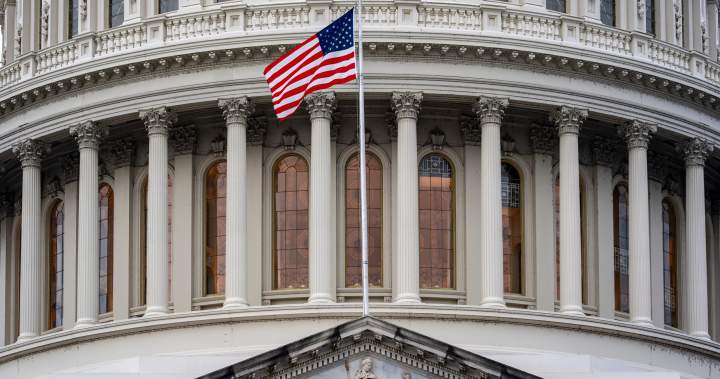A partial U.S. government shutdown will likely have a domino effect on the next interest rate decision by the U.S. Federal Reserve, economists say, and Canada could see resulting impacts as well.
Many U.S. agencies’ work came to a standstill and hundreds of thousands of employees were furloughed starting at midnight Wednesday after lawmakers failed to reach a short-term funding agreement.
Among those affected are the statistical agencies — including the U.S. Bureau of Labor Statistics and the U.S. Census Bureau — whose economic data is relied upon by the American central bank in deciding whether to change its baseline interest rate.
If the shutdown persists, economists agree that a compounding lack of data will make it more likely the Fed will keep the rate steady, despite facing intense political pressure to keep cutting amid growing economic uncertainty.
That will have implications north of the border, said Gary Hufbauer, a non-resident senior fellow at the Peterson Institute for International Economics.
“If interest rates in the U.S. are not cut in October by 25 basis points, that will certainly surely affect Canadian interest rates,” he said in an interview.
The Bank of Canada and the U.S. Fed are set to announce their respective interest rate decisions on Oct. 29, after reviewing the latest domestic and global economic data.
Both central banks delivered their first rate cuts in months on Sept. 17, though the U.S. Fed had waited since December 2024 to shave 25 basis points off its rate.
The American rate remains far higher — at 4.15 per cent — than the Bank of Canada’s current policy rate of 2.5 per cent. That has angered U.S. President Donald Trump, who has called on the Fed to drastically lower rates to boost the economy.
Fed Chair Jerome Powell has pointed out that U.S. inflation remains stubbornly high at 2.9 per cent, and outside the central bank’s target range, while unemployment is also rising. Powell has also said Trump’s global tariff policy continues to add to the greater economic uncertainty.

Get breaking National news
For news impacting Canada and around the world, sign up for breaking news alerts delivered directly to you when they happen.
The U.S. inflation rate is also higher than Canada’s, which currently sits at 1.9 per cent.
The timing of the government shutdown is “not ideal for the Fed,” RBC economists Mike Reid and Carrie Freestone wrote in a note on Friday, because “we will not get initial jobless claims data on Thursday nor employment data from nonfarm payrolls or the Household Survey on Friday.”
If the shutdown lasts until Oct. 15, the economists warned, there is a “non-zero risk” that the Fed won’t receive the latest consumer price index data before its Oct. 29 meeting.
Derek Holt, a vice-president and senior economist at Scotiabank, warned similarly in his own analysis on Friday that “a few other indicators like claims, construction spending, and factory orders” will be similarly delayed by a prolonged shutdown, leaving markets and the Fed guessing on the state of the U.S. economy.
“The prudent response from the Fed would be to hold steady on interest rate in the absence of reliable information about the state of the labour market, or inflation,” Werner Antweiller, an international economics professor at the University of British Columbia, said in an email.
“The result could be that monetary policy may be out of tune with the economic realities of the U.S. economy.”
The Bank of Canada’s interest rate decisions also factor in U.S. economic data and that of other major global markets, which could similarly lead to a rate freeze, Hufbauer said.
One aspect of the economy that won’t be impacted by a shutdown will be the collection of U.S. tariff revenue.
A contingency plan for the U.S. Department of Homeland Security, posted online Monday, says collection by U.S. Customs and Border Protection (CBP) will be deemed an essential service in the event of a shutdown.
CBP agents tasked with border enforcement and staffing official crossings will also be exempt from furlough or layoffs, the plan says, though they will have to work without pay until the shutdown ends and backpay can be provided.
Most of the nearly 272,000 Homeland Security employees will be kept on during a shutdown, according to the contingency plan, including more than 63,000 CBP employees.
The federal work stoppage could impact travellers who may face longer lines at American airports and closures at U.S. national parks, as only essential staff will be kept on.
Antweiller said the economic impact of a government shutdown on Canada may grow the longer it drags on.
“Past six to seven weeks, we’re into new territory, and the U.S. economy could and likely would weaken somewhat,” he wrote. “This means demand for Canadian goods could suffer, especially where procurement from the U.S. government is involved directly.”
He added that the situation would be aggravated if the Trump administration moves to cut federal workforces rather than temporarily furloughing employees. That would push up unemployment rates and further affect the data submitted to the Federal Reserve.
The last time the U.S. government neared a shutdown, in 2023, economists said a prolonged shutdown would rock investor and consumer confidence on both sides of the border.
The difference this time, economists note, is that Canada is already moving away from the U.S. for trade and investment amid Trump’s trade war, which makes the American instability less of a factor.
Read the full article here

